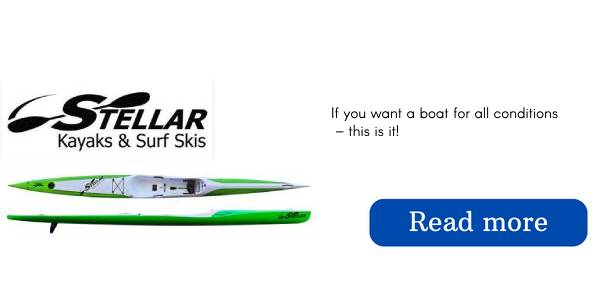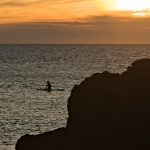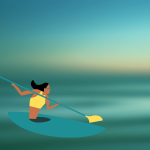You have become acquainted with and exercised all of the fundamentals: the forward stroke, the sweep, the stern rudder, the draws, and the braces.
When a person has gone out exploring in the wind and the waves while kayaking, they may notice that when they’re not paddling, their kayak will usually point in the direction of the wind and parallel to the waves.
While traveling and rowing against the wind, many people will typically drift more towards the direction of the wind, aiming the front of their boats nearly into the wind, or within a 30-45 degree angle.
This outcome can make it a challenge to remain on the desired path while steering the vessel, which can lead to exhaustion and disappointment for a sailor who is not armed with the knowledge of why this occurs.
This is due to the impact of numerous physical elements that are acting on the boat and each of them will be looked into in detail.
Using powerful strokes from the paddle and the rudder, results may be seen differently, but the weary paddler could quickly find themselves unable to keep a straight course, just like a weathervane chicken atop Grandpa’s roof, and endeavoring to reach their goal.
We should examine the various components that affect weathercocking in sea kayaks, starting with the most critical ones.
Under Pressure
Each vessel, be it a giant cargo ship or a small plastic kayak, makes a pressure wave pattern with a remarkable shape while it moves through the water. When looking from above, there are distinct parts of high pressure present surrounding the boat’s ends (stronger at the bow and lighter at the stern), with a thin region of low pressure pressurizing the middle.
The exact dimensions and form of this track will differ depending on the speed and structure of the kayak, but it is these areas of pressure, which follow the kayak through the water, resulting in the wakes at the front and back.
Generally, these forces are balanced evenly on the left and right sides of the vessel, making it so the kayak goes in a straight line. When paddling with the wind, the strong wind affects the boat by applying a lateral force down the entire length of one side of the boat.
The bigger high-pressure area on the bow of the boat works to counter the sidelong thrust and the smaller high-pressure region at the back end of the boat provides less hindrance, so the overall effect is that the wind coming from the side is able to veer the stern more than it does the bow.
The outcome of the force causes the back end of the boat to be shifted away from the wind, and the front part of the boat to be pushed in the direction of the wind– a familiar occurrence that is known as weathercocking.
The faster you paddle, the more likely it is that your kayak will experience weathercocking, because the pressure on your kayak increases when it’s speeding up and dissipates when it slows down.
Waves
Beam winds are definitely the main cause, however water can have a great impact on your kayak’s structure as well.
When the wind generates waves that hit the side of your kayak as it is moving, these waves experience the same disparate level of resistance due to the higher pressure at the larger front of the vessel in comparison to the back, leading to similar results.
Therefore, the stern will be turned to face the wind and waves to a greater degree than the bow, resulting in the vessel weathervaning into the wind and waves.
Find Your Center
Grandpa’s weathervane situated at the top of the barn accurately points in the direction of the wind since the force of the wind on the part behind the point of rotation is greater than the force on the part ahead of it.
So too does your kayak. You and your kayak have a central point around which everything revolves, much like a weathervane; your combined center of gravity.
If you have made the front of the boat disproportionately weighty, the wind is able to push the back end of the boat off in the opposite direction from the wind and pull the bow closer into the wind.
Solutions
How can one keep control over their boat with Neptune and the laws of Newtonian mechanics pulling them in a different direction?
A few strategies exist to keep a kayak aimed straight into the wind and the waves. Let’s sort out the most successful before proceeding.
Skegs & Rudders
When a sea kayak is planned and designed, its creator determines at the beginning whether a rudder or a skeg will be part of its design. This choice impacts many of the kayak’s final characteristics. Rudders and skegs are not the same, so be sure that your kayak uses the system that is most suitable for the shape of its hull.
Native Arctic peoples discovered that when they built kayaks with deeper, thin fin-shaped keels in the back, the boats would track better, particularly when there were winds blowing across the bow. The contemporary sea-kayak skeg is both a symbolic and literal extension of what preceded it, but it is able to be adjusted to adapt to changing circumstances with minor alterations.
Basically, by strengthening the resistance of the kayak’s back end, it is more capable of resisting the side-to-side motion from the gust of wind. The tough opposition to the water is supplemented by the force of the point of maximum resistance, allowing the kayak to remain on track.
The amount of skeg used could be changed depending on the intensity and direction of the wind in relationship to the route of the kayak: stiff and direct winds require more skeg for continuing on a crosswind course, and for kayaking without wind, it is likely no skeg is necessary.
Rudders
Kayak rudders are just like the ones used on larger sailboats, vessels, and so on; they help in the back of the boat by providing directional stability. Rudders differ from skegs, however, in several ways. The rudder is either out all the way or completely brought in, not altered in increments.
A trait that sets the rudder apart from the skeg is its ability to be steered. The rudder is typically operated using sliding foot pedals, which can be used to adjust it from side to side as a sort of trim tab for providing lateral resistance in crosswinds, similar to a skeg.
When the wind is trying to make the aircraft veer to the right, use a slight left turn on the rudder to keep it flying in a straight line.
Basic paddling position
We are going to accept that you possess a European-style paddling oar featuring huge, slighty bowl-shaped blades. The side of the blade that is curved inward is the “power face”, while the opposite side is considered the back. The blades are typically aligned at an inclination to one another, a procedure which is referred to as “feathering” or “off-setting”. The paddles illustrated in Kayarchy are right-handed.
Put your hands on the paddle shaft with a separation that is easy to handle. Position the correct blade vertically so that its power-generating side is facing the rear. The other blade is now almost level, with the energy source of the blade facing upward.
This is your basic paddling position. The way you grasp your paddle when paddling forward or backward, turning or carrying out stability strokes is very important. Usually, you have to keep your kayak in this position so that you can paddle it.
With a European-style paddle, your hands should be able to precisely pinpoint the same two points on the paddle shaft at a moment’s notice, even if you were to lose your grip or end up upside down.
A lot of kayakers wind waterproof tape around the shaft of their paddle to signify the parts which should be easier to identify.
They can also add a bit of cushioning underneath the adhesive so the pole is oval in that area. This is called indexing.
How to paddle forwards
To propel your canoe forward, simply dip the paddle blade in the water and pull it towards you, switch arms and perform the same action on the opposite side.
However, the majority of individuals use an oar with blades that have feathers or are staggered. We suppose that you possess a paddle with feathers that can be operated with your right hand at Kayarchy.
Your dominant hand should be firmly holding the paddle while keeping a light grip. Keep your body upright in the kayak and hold the paddle with the right blade vertical with the curved side facing towards the back of the vessel. Extend your right paddle, submerge it and then bring it back.
Now reach forward with the left blade. Rotate the shaft by rolling your right wrist in a backwards motion, so that it is at an angle suitable for entering the water. As if you are revving up a motorbike.
Do not turn your left wrist inward in an excessive manner, just loosen the grip of your left hand so the shaft can move with no obstruction. Insert the left blade into the liquid, and pull it in the opposite direction.
And that concludes all the steps necessary for propelling oneself with a paddle in a sea kayak. Go gently to start with. If you attempt to do this now with a lot of speed and vigor, you may find yourself in over your head. No need to be overly concerned about maintaining a direct path.
Essentially, that is all there is, but there are areas to be enhanced.
Body rotation
You can utilize just your arm muscles when rowing forwards, yet it is preferable to utilize the more substantial and robust muscles in your back and torso to get more of the job done.
Even your leg muscles can make a contribution. It is simple to incorporate “torso rotation” into your paddling approach.
More improvements
Make sure that all of the paddle’s blade remains in the water, without any part of the handle dipping in.
Try always to sit upright to paddle. Leaning backwards while paddling is more draining and decreases the amount of control that you have.
Try taking longer, slower strokes. Beginners rarely perform strokes which are prolonged and sluggish, however the contrary is very frequent.
The only moment you should firmly hold the paddle is when you are vigorously powering or propelling yourself out through the waves. If you find yourself in a frightful circumstance and notice that your paddle is clenched in your grip, try to loosen your hold.
You’re wasting energy. Try stretching your fingers of the top hand when pushing it forward on a long journey. This will help the flow of blood in your hand and arms.
Coping with wind from the side
When kayaks are hit by a side breeze, they usually veer into the direction of the wind. This is called weather helm or weathercocking. Some sea kayaks have a skeg or rudder attached to help decrease turning radius.
Kayaks can sometimes veer off into a downwind direction, an effect that is commonly referred to as “lee helm” or “leecocking”.
You can prevent the tendency of a boat to turn into the wind by putting in more effort when paddling on the upwind side or doing a sweep stroke on the same side. If this becomes too bothersome, you can alter your grip so the paddle is outstretched more to one side rather than the other one.
Say you keep turning to the left. Move your hands up the handle of the paddle, and place each hand 15 cm to the right of where you normally would grip it. Keep on paddling as normal.
If you employ a Greenland paddle, it is simple to keep a lengthy grip, or you can also execute the gliding stroke on one side.
If you plan to travel overnight, you may need to rearrange the contents of your kayak a short way into your journey to increase its maneuverability. In windy environments, it is recommended that kayaks be set up such that the back is more weighted than the front for optimal performance.
Getting technical
If you are looking for specific instructions, here is how to move forward using paddles. We prioritize comfort over speed when it comes to how we do things.
Hold the paddle the usual way. Sit upright or leaning very slightly forwards. Hold your left arm up around the height of your shoulder or slightly above it but with the arm extended out approximately 30 cm away from your body.
Extend your right arm in front of you to the maximum that you can handle comfortably. Put the blade in the water. The paddle’s length will determine approximately where it enters the water, which will be near your right foot.
Move your right hand towards you while keeping the right oar blade near the kayak in the water. Move your left hand forward as you turn your torso to the right.
A clear indication that you are paddling correctly is the movement of your left hand from the left side to the right side in such a way that upon finishing the stroke, it is at or even beyond the middle line of the kayak.
Move your right arm in a backward motion while bending your elbow so that the paddle stays just below the water. Continue moving your right hand back until it is alongside your hip.
Take the blade out of the water and bring your right arm up until it is in front of your right shoulder.




